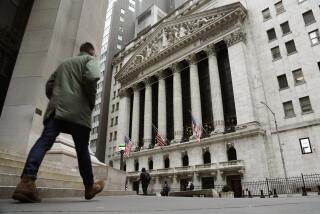Inflation Takes a Turn for the Worse
- Share via
WASHINGTON — After seeming all but banished, inflation made an unexpected comeback last month, driving consumer prices to their biggest one-month gain since the beginning of the 1990s and leaving a lot of people wondering how much longer the era of easy economic growth can continue.
Almost half of the unexpectedly sharp 0.7% jump in the consumer price index is traceable to gasoline prices, which, according to one measure, leaped a staggering 17%, the largest one-month increase since the government began keeping records in 1935.
The surge in gasoline prices might have been a onetime event, analysts noted. But what really startled economists and investors was that prices seemed to be headed higher in almost every corner of the economy. Housing was up 0.4%. Movie tickets rose 1.4%. Clothes climbed 1.5%. Airline fares lifted a full 2%.
“Some of this is catch-up, but there’s an underlying trend that we have to be concerned with,” said Diane C. Swonk, deputy chief economist for Bank One Corp. in Chicago.
The day’s selling knocked the Dow Jones industrial average off its latest record high and sent it down 193.87 points, or 1.75%, to 10,913.32.
As important, the sell-off slashed the price of U.S. Treasury bonds, pushing up the yield on the 30-year bond to 5.91%, its highest level in almost a year. A sustained increase in yields or market interest rates could slow the economy by making loans more expensive for buying a home or car or for financing a business.
Of most immediate concern is what the Federal Reserve will do about the new numbers when it meets Tuesday. A wide variety of analysts predicted the central bank will take its first tentative steps toward raising interest rates by changing its so-called bias in favor of tightening.
Investors showed little inclination Friday to wait and see how the Fed reacts, preferring instead to dump stocks and bonds in anticipation of an eventual rate increase.
April’s 0.7% increase in consumer prices contrasted with a 0.2% increase in March. Forecasters had generally predicted a 0.4% increase in April. The so-called core rate of inflation, excluding volatile food and energy prices, rose 0.4% in April, double expectations.
The numbers were especially rattling because they represent the first pieces of bad economic news that the country has had to digest in months. They seem to poke a hole in sunny claims about the nation’s ability to grow indefinitely with the kinds of trouble that have dogged other expansions.
“We haven’t repealed the old rules. Sooner or later, low unemployment and sustained growth produces inflation,” said Stephen S. Roach, chief economist at Morgan Stanley Dean Witter in New York. “Everybody has gotten too complacent about inflation.”
Analysts were quick to point out that one month’s numbers do not make a trend and that several of the price increases contributing to the April jump are unlikely to repeat.
For example, the price of energy, which includes gasoline, rose 6.1% during the month but is unlikely to go higher, according to some forecasters. “That’s the bulk of the increase we’ll see for the year,” said Bruce Steinberg, chief economist of Merrill Lynch & Co.
Similarly, tobacco prices dropped a sharp 3.5% in March, contributing to an unusually low inflation rate that month, and then snapped back a nearly identical 3.6% in April.
In each case, according to the Bureau of Labor Statistics, which compiles the price figures, the change was because of cigarette makers’ discounting practices and not to underlying price changes.
“There’s no big trend in these numbers,” said Kathleen Camilli, chief economist for Tucker Anthony & Co. in New York.
In addition, analysts said a string of recent government reports showed that wages, a key determinant of inflation, were still subdued despite record low unemployment.
Nevertheless, the breadth of the April price increases had many observers worried that the economy is entering a new and more difficult period. For the first four months of the year, inflation was running at a 3.3%, seasonally adjusted annual rate, according to the BLS. That is double the 1.6% annual rate of last year--and more than enough to wipe out the value of the wage gains most Americans are now receiving.
“The easy ride is over,” said Roger E. Brinner, chief economist and managing director of the Parthenon Group, a Boston consulting firm.
The last time the CPI jumped 0.7% in a month was in October 1990, before the economy began its current record-setting expansion, according to the BLS. Price increases in many spending categories followed a similar pattern.
The 1.5% increase in clothing costs was the largest monthly gain since March 1990. The 2.4% rise in transportation costs, which includes airline fares, was the largest since 1981.
Virtually the only spending category where prices dropped during the month was computers and communication equipment, which declined 1.4%.
* CALIFORNIA JOBS: The state reported a drop in unemployment rate to 5.6%. C1
(BEGIN TEXT OF INFOBOX / INFOGRAPHIC)
Inflation Watch
The consumer price index surged in April, led by gasoline costs:
April: 0.7%
Gasoline: +17.0
Tobacco: +3.6
Apparel: +1.5
Prescriptions: +0.8
Source: Bureau of Labor Statistics
More to Read
Inside the business of entertainment
The Wide Shot brings you news, analysis and insights on everything from streaming wars to production — and what it all means for the future.
You may occasionally receive promotional content from the Los Angeles Times.









